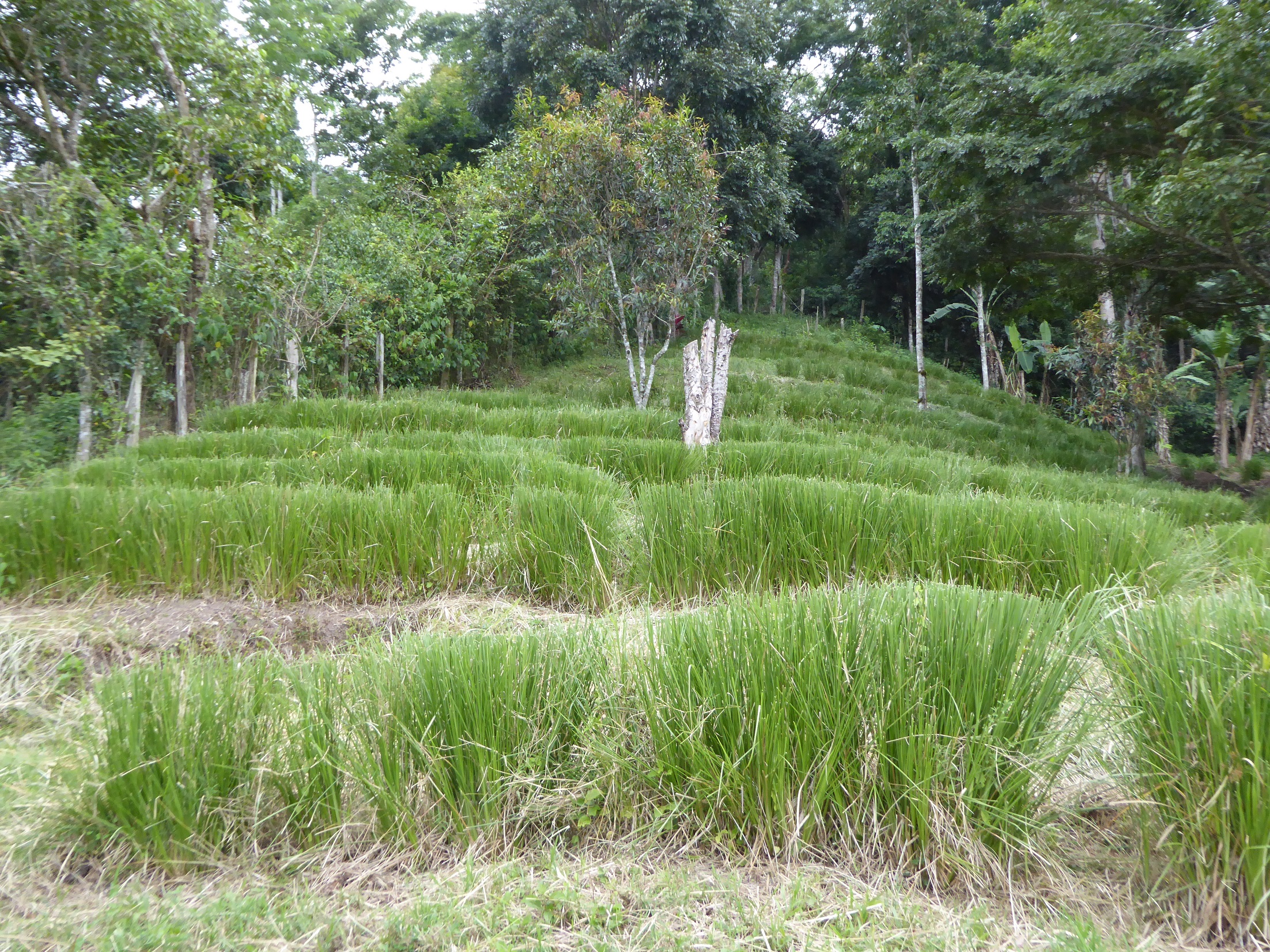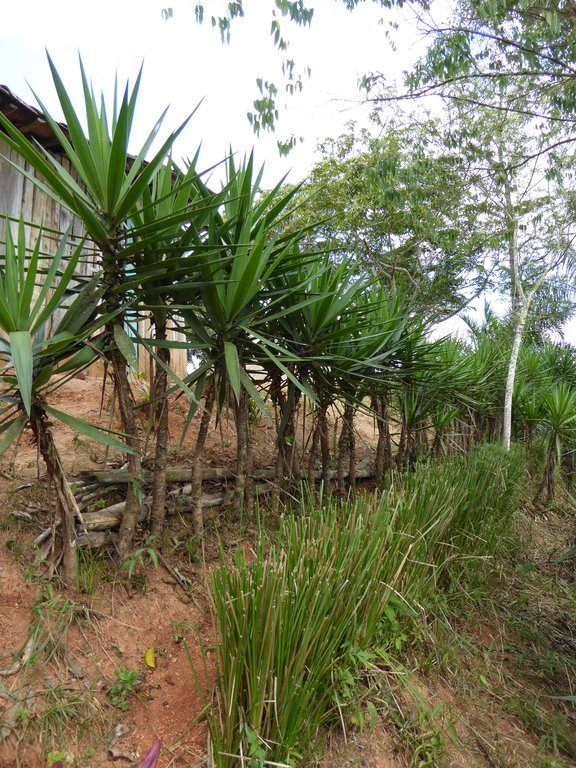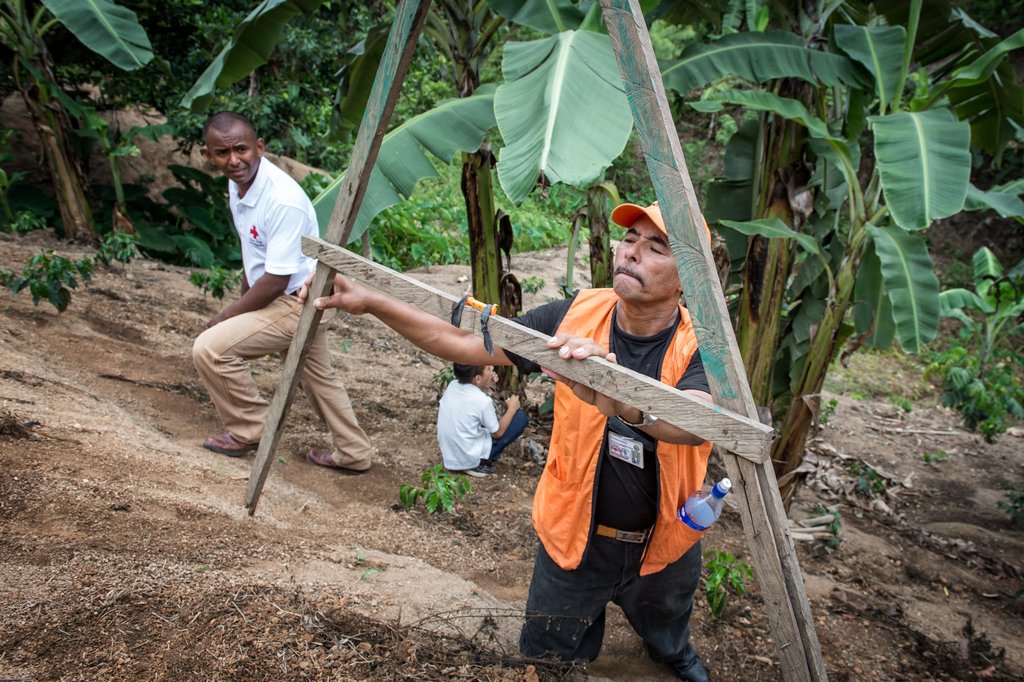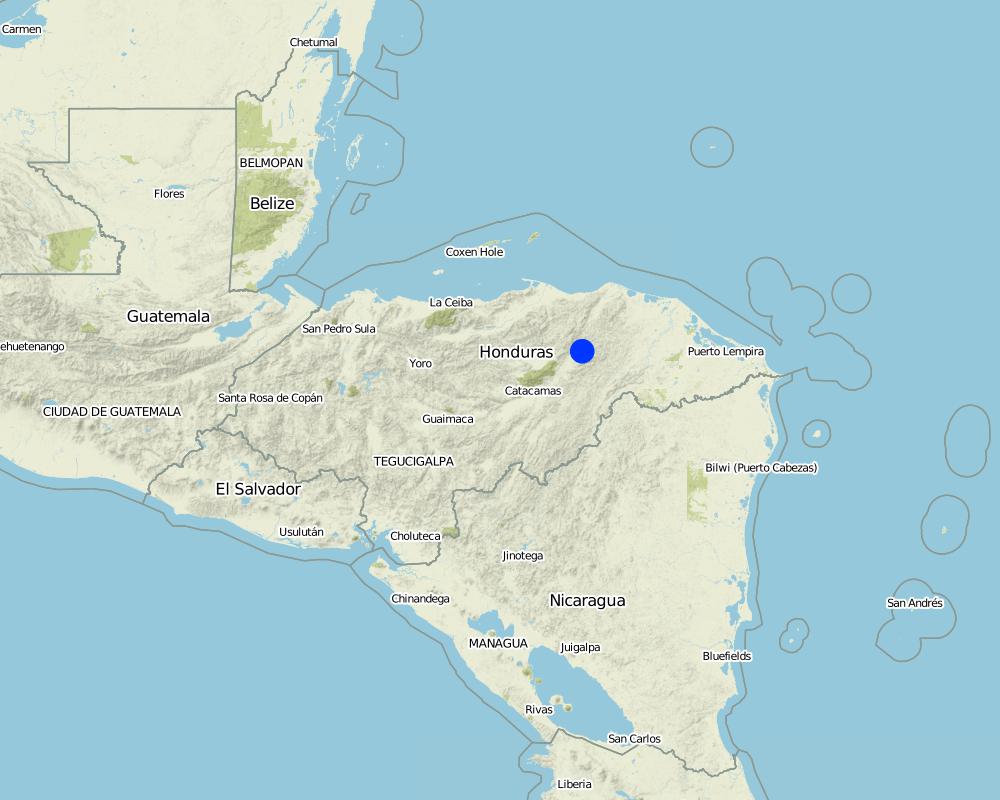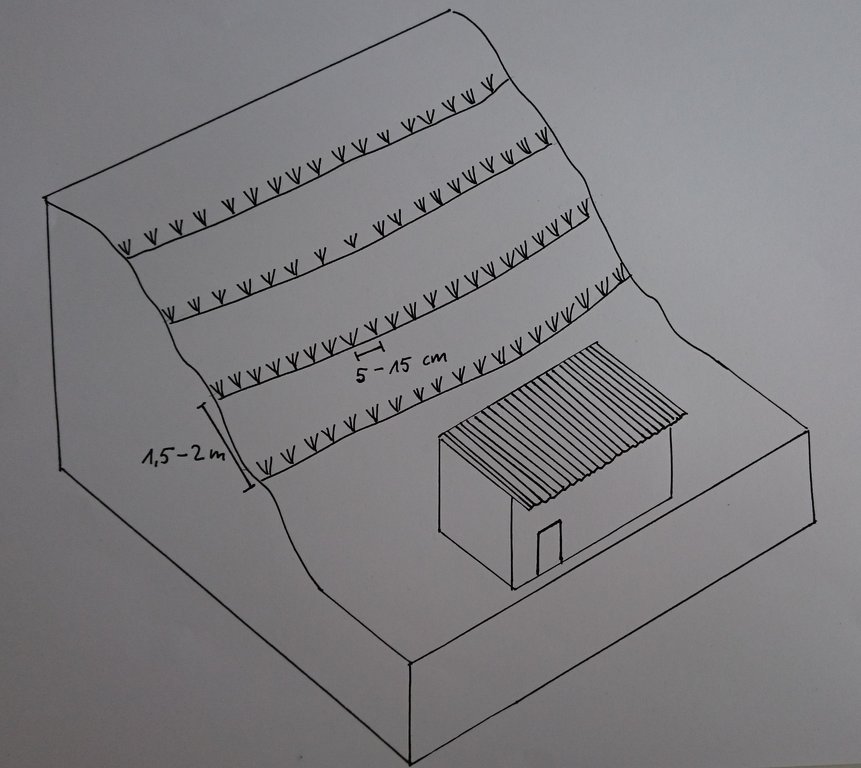Curved and tiered live hedges [Honduras]
- Creation:
- Update:
- Compiler: Helen Gambon
- Editor: Anton Jöhr
- Reviewers: Alexandra Gavilano, Johanna Jacobi
technologies_735 - Honduras
View sections
Expand all Collapse all1. General information
1.2 Contact details of resource persons and institutions involved in the assessment and documentation of the Technology
Key resource person(s)
land user:
Pastrana Medina Ever
Honduras
SLM specialist:
Paguada Carmen
Honduran Red Cross
Honduras
land user:
Rivas Vicente Alonso
Honduras
Name of project which facilitated the documentation/ evaluation of the Technology (if relevant)
Book project: where people and their land are safer - A Compendium of Good Practices in Disaster Risk Reduction (DRR) (where people and their land are safer)Name of the institution(s) which facilitated the documentation/ evaluation of the Technology (if relevant)
Swiss Red Cross (Swiss Red Cross) - Switzerland1.3 Conditions regarding the use of data documented through WOCAT
The compiler and key resource person(s) accept the conditions regarding the use of data documented through WOCAT:
Yes
1.4 Declaration on sustainability of the described Technology
Is the Technology described here problematic with regard to land degradation, so that it cannot be declared a sustainable land management technology?
No
Comments:
Vetiver grass is not native, it comes from Asia. However, it is not problematic since it is a non-invasive species (as confirmed by observation of places where it has been grown for over 100 years).
1.5 Reference to Questionnaire(s) on SLM Approaches (documented using WOCAT)
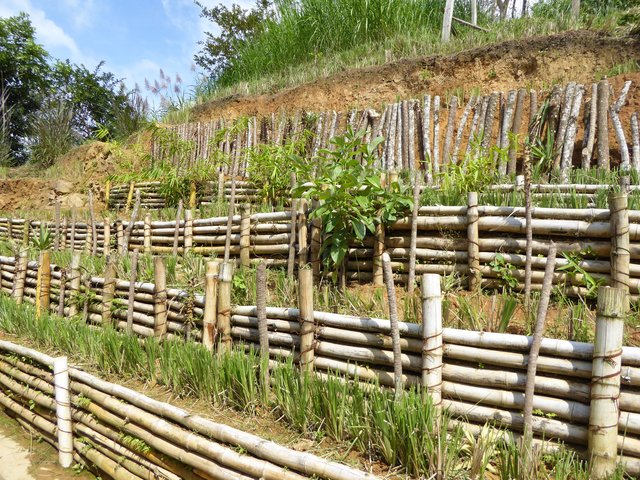
Participative Slope Stabilization [Honduras]
Bioengineering includes a series of techniques based on the use of live vegetation to protect slopes and embankments from erosion and landslides. Bioengineering works are applied according to comprehensive risk assessment; they are multipurpose as a whole, have a low cost of consdtruction and maintenance cost,they enhance the capacities of …
- Compiler: Helen Gambon
2. Description of the SLM Technology
2.1 Short description of the Technology
Definition of the Technology:
Live hedges are rows of perennial plants, eg. vetiver grass (Vetiveria zizanioides) or izote (Yucca sp.), with dense growth and deep roots, planted on terraced curves in order to control erosion and preserve water. The plant can be used as medicine or fodder (vetiver) or food (izote flower).
2.2 Detailed description of the Technology
Description:
The Department of Olancho is a rainforest located in Cordillera Central and Sierra de Agalta, at an average altitude of 1500 masl. In spite of having large protected areas, the agricultural frontier (agriculture and livestock) is being expanded mainly by large landowners and, to a lesser degree, by peasants. This change in land-use also involves burning, a practice that furthers soil degradation. The Department of Olancho is frequently affected by tropical storms and hurricanes from the Atlantic. This combination of frequent and intense natural phenomena, the level of susceptibility and inadequate use of natural resources, generally causes significant damage and even the loss of human lives.
Terraced curved live hedges are grown on unstable slopes and those tending towards erosion and instability. Vetiver has proven effective in stabilizing slopes. It is a perennial grass that is highly adaptable to a broad variety of conditions. Though it can grow in degraded soils, and in dry or humid conditions, it requires sun and does not do well in the shade. Vetiver roots can grow over 3 meters and intertwine tightly.
Vetiver is palanted in densly clustered rows on terraced curves. Thus, it protects the slope by reducing the speed of surface rainwater run-off; it also enables water to filter into the ground and reduces soil erosion; further, it acts as a filter and retains sediment. Good management of live hedges results in the gradual formation of terraces. Terraced curved live hedges are frequently combined with other bioengineering technologies, such as draining trenches or terracing. For more information on implementing live hedges with vetiver grass, see the technical drawing. If the hedges are planted during the summer, these need to be watered every three days; the plant grows on their own during the winter. The space between the grass rows can be used to grow vegetables, since nutrients accumulate here. The hedges must be trimmed to 50 cm every two months to strengthen them. All empty spaces along the hedges have to be filled. Also, it is important to weed the hedges. Sprouts can be used to plant new hedges.
Izote (Yucca Gigantea flowers) or pineapple (Ananas comosus) may be used instead of vetiver. Izote can be planted in dense rows or at a distance of up to 30 cm. Additional measures can be used to enhance effectiveness according to the slope, such as planting bushes behind the izote plants. Pineapples are planted at a distance of 30-50 centimeters. Though it does not have deep roots, it does grow densely. Pineapples are frequently planted in hedges growing close to homes or schools, because vetiver grass tends to attract rodents and snakes.
In this case study, live hedges of vetiver grass on terraced curves have been implemented through the Honduran/Swiss Red Cross Project “Resiliencia”. This project aims at providing sustainable support to enhance resilience in all rural regions in Olancho, and to help reduce risks of disasters and to promote health at all levels (home, community, municipality). Bioengineering works are implemented in critical areas according to risk assessments.
2.3 Photos of the Technology
2.5 Country/ region/ locations where the Technology has been applied and which are covered by this assessment
Country:
Honduras
Region/ State/ Province:
Departament of Olancho
Further specification of location:
Dulce Nombre de Culmí Municipality , Nueva Esperanza Community
Specify the spread of the Technology:
- evenly spread over an area
If precise area is not known, indicate approximate area covered:
- < 0.1 km2 (10 ha)
Map
×2.6 Date of implementation
Indicate year of implementation:
2012
2.7 Introduction of the Technology
Specify how the Technology was introduced:
- through projects/ external interventions
3. Classification of the SLM Technology
3.1 Main purpose(s) of the Technology
- reduce, prevent, restore land degradation
- reduce risk of disasters
3.2 Current land use type(s) where the Technology is applied
Land use mixed within the same land unit:
Yes
Specify mixed land use (crops/ grazing/ trees):
- Agroforestry

Cropland
- Annual cropping
- Perennial (non-woody) cropping
- Tree and shrub cropping
Annual cropping - Specify crops:
- cereals - maize
- root/tuber crops - cassava
- vetiver
Perennial (non-woody) cropping - Specify crops:
- pineapple
Specify:
n/a
Comments:
Vetiver grass (Vetiveria zizanioides) or izote (Yucca sp.)
3.3 Has land use changed due to the implementation of the Technology?
Has land use changed due to the implementation of the Technology?
- Yes (Please fill out the questions below with regard to the land use before implementation of the Technology)

Unproductive land
Remarks:
Slopes stabilized with live hedges were mostly non-productive land; however, in some cases, they were used for extensive grazing.
3.4 Water supply
Water supply for the land on which the Technology is applied:
- rainfed
3.5 SLM group to which the Technology belongs
- cross-slope measure
3.6 SLM measures comprising the Technology

vegetative measures
- V2: Grasses and perennial herbaceous plants
3.7 Main types of land degradation addressed by the Technology

soil erosion by water
- Wt: loss of topsoil/ surface erosion
- Wm: mass movements/ landslides
3.8 Prevention, reduction, or restoration of land degradation
Specify the goal of the Technology with regard to land degradation:
- reduce land degradation
4. Technical specifications, implementation activities, inputs, and costs
4.1 Technical drawing of the Technology
Technical specifications (related to technical drawing):
Create terraced curves with method A (spirit level)
- A trench 10 cm deep is dug out.
- A plant is placed every 5 cm, if its root is short, and at 10-15 cm if the root is longer.
- The roots are covered with soil.
- The plants ust be watered every three days in summer.
Author:
Helen Gambon, Swiss Red Cross
Date:
01/12/2016
4.2 General information regarding the calculation of inputs and costs
Specify how costs and inputs were calculated:
- per Technology area
Indicate size and area unit:
1250 linear meters
other/ national currency (specify):
Lempiras
If relevant, indicate exchange rate from USD to local currency (e.g. 1 USD = 79.9 Brazilian Real): 1 USD =:
23.0
Indicate average wage cost of hired labour per day:
150 Lempiras
4.3 Establishment activities
| Activity | Timing (season) | |
|---|---|---|
| 1. | Clean the land | |
| 2. | Bring hedge plants (vetiver) to site | |
| 3. | Define terraced curves using A-frame level tool | |
| 4. | Loosen soil with shovel and pike | |
| 5. | Plant vetiver, in groups of 2-3 every 15 cm | preferably during winter (rainy season) |
Comments:
Izote and pineaple are planted 30 - 40 cm apart
4.4 Costs and inputs needed for establishment
| Specify input | Unit | Quantity | Costs per Unit | Total costs per input | % of costs borne by land users | |
|---|---|---|---|---|---|---|
| Labour | Trained labor | person day | 0.5 | 200.0 | 100.0 | |
| Labour | Untrained labor | person day | 24.0 | 150.0 | 3600.0 | 100.0 |
| Equipment | shovel, pike | pieces | 12.0 | 2.0 | 24.0 | 100.0 |
| Equipment | A-frame level tool | piece | 1.0 | 5.0 | 5.0 | |
| Plant material | Vetiver | meter | 1250.0 | 5.0 | 6250.0 | 50.0 |
| Total costs for establishment of the Technology | 9979.0 | |||||
| Total costs for establishment of the Technology in USD | 433.87 | |||||
If land user bore less than 100% of costs, indicate who covered the remaining costs:
Honduran / Swiss Red Cross
Comments:
Costs were estimated for largest area (1250 linear meters). Smaller areas require less untrained labor and plants.
4.5 Maintenance/ recurrent activities
| Activity | Timing/ frequency | |
|---|---|---|
| 1. | Weed control | |
| 2. | Fill empty spaces along the hedge | |
| 3. | Trim vetiver hedge to 50 cm to ensure density | Every two months |
4.6 Costs and inputs needed for maintenance/ recurrent activities (per year)
| Specify input | Unit | Quantity | Costs per Unit | Total costs per input | % of costs borne by land users | |
|---|---|---|---|---|---|---|
| Labour | Untrained labor | person half-day | 20.0 | 150.0 | 3000.0 | 100.0 |
| Equipment | Trimming garden scissors | pieza | 1.0 | 5.0 | 5.0 | 100.0 |
| Total costs for maintenance of the Technology | 3005.0 | |||||
| Total costs for maintenance of the Technology in USD | 130.65 | |||||
4.7 Most important factors affecting the costs
Describe the most determinate factors affecting the costs:
- area extension
- purchase of plants for live hedge, if these are not locally available
5. Natural and human environment
5.1 Climate
Annual rainfall
- < 250 mm
- 251-500 mm
- 501-750 mm
- 751-1,000 mm
- 1,001-1,500 mm
- 1,501-2,000 mm
- 2,001-3,000 mm
- 3,001-4,000 mm
- > 4,000 mm
Specify average annual rainfall (if known), in mm:
1400.00
Specifications/ comments on rainfall:
Dry season from january to June, rainy season between June and October, with a heat wave in August. .
Agro-climatic zone
- sub-humid
5.2 Topography
Slopes on average:
- flat (0-2%)
- gentle (3-5%)
- moderate (6-10%)
- rolling (11-15%)
- hilly (16-30%)
- steep (31-60%)
- very steep (>60%)
Landforms:
- plateau/plains
- ridges
- mountain slopes
- hill slopes
- footslopes
- valley floors
Altitudinal zone:
- 0-100 m a.s.l.
- 101-500 m a.s.l.
- 501-1,000 m a.s.l.
- 1,001-1,500 m a.s.l.
- 1,501-2,000 m a.s.l.
- 2,001-2,500 m a.s.l.
- 2,501-3,000 m a.s.l.
- 3,001-4,000 m a.s.l.
- > 4,000 m a.s.l.
Indicate if the Technology is specifically applied in:
- not relevant
5.3 Soils
Soil depth on average:
- very shallow (0-20 cm)
- shallow (21-50 cm)
- moderately deep (51-80 cm)
- deep (81-120 cm)
- very deep (> 120 cm)
Soil texture (topsoil):
- fine/ heavy (clay)
Soil texture (> 20 cm below surface):
- fine/ heavy (clay)
Topsoil organic matter:
- medium (1-3%)
5.4 Water availability and quality
Ground water table:
< 5 m
Availability of surface water:
good
Water quality (untreated):
poor drinking water (treatment required)
Is water salinity a problem?
No
Is flooding of the area occurring?
No
5.5 Biodiversity
Species diversity:
- medium
Habitat diversity:
- medium
5.6 Characteristics of land users applying the Technology
Sedentary or nomadic:
- Sedentary
Market orientation of production system:
- mixed (subsistence/ commercial)
Off-farm income:
- less than 10% of all income
- 10-50% of all income
Relative level of wealth:
- poor
Individuals or groups:
- individual/ household
- groups/ community
Level of mechanization:
- manual work
Gender:
- men
Age of land users:
- youth
- middle-aged
Indicate other relevant characteristics of the land users:
In areas where the technology is applied, a significant number of men have migrated to USA. Women do not work on their plots, but rather look for jobs at farms or coffee plantations in the region. Thus, men who stay behind have a greater work load. Many families receive remittances.
5.7 Average area of land used by land users applying the Technology
- < 0.5 ha
- 0.5-1 ha
- 1-2 ha
- 2-5 ha
- 5-15 ha
- 15-50 ha
- 50-100 ha
- 100-500 ha
- 500-1,000 ha
- 1,000-10,000 ha
- > 10,000 ha
Is this considered small-, medium- or large-scale (referring to local context)?
- small-scale
5.8 Land ownership, land use rights, and water use rights
Land ownership:
- individual, not titled
Land use rights:
- individual
Water use rights:
- communal (organized)
Comments:
There are may examples where this Technology was used in the school's community lands. This data was provided by members of the local emergency committee (CODEL) and Education Commitee, who implemented the technology to protect the school.
5.9 Access to services and infrastructure
health:
- poor
- moderate
- good
education:
- poor
- moderate
- good
technical assistance:
- poor
- moderate
- good
employment (e.g. off-farm):
- poor
- moderate
- good
markets:
- poor
- moderate
- good
energy:
- poor
- moderate
- good
roads and transport:
- poor
- moderate
- good
drinking water and sanitation:
- poor
- moderate
- good
financial services:
- poor
- moderate
- good
6. Impacts and concluding statements
6.1 On-site impacts the Technology has shown
Socio-economic impacts
Production
crop production
product diversity
Comments/ specify:
En muchos casos se complementan con arboles frutales, maíz, y/o produccion de forraje
production area
Comments/ specify:
Las barreras vivas permiten a los usuarios de tierra de aumentar el área productivo y poner en uso tierras anteriormente baldías.
Socio-cultural impacts
food security/ self-sufficiency
health situation
Comments/ specify:
Las casas están mejor protegidas contra la hmuedad, y la alimentación está más equilibrada.
community institutions
Comments/ specify:
La tecnología se implementa a través de los Comités de Emergencia Local (CODEL), quienes han sido fortalecidos por el trabajo en conjunto y las capacitaciones recibidas.
SLM/ land degradation knowledge
Ecological impacts
Water cycle/ runoff
surface runoff
excess water drainage
Soil
soil loss
Climate and disaster risk reduction
landslides/ debris flows
impacts of cyclones, rain storms
6.2 Off-site impacts the Technology has shown
damage on public/ private infrastructure
6.3 Exposure and sensitivity of the Technology to gradual climate change and climate-related extremes/ disasters (as perceived by land users)
Gradual climate change
Gradual climate change
| Season | increase or decrease | How does the Technology cope with it? | |
|---|---|---|---|
| annual temperature | increase | very well | |
| seasonal temperature | summer | increase | very well |
| seasonal rainfall | summer | decrease | very well |
Climate-related extremes (disasters)
Meteorological disasters
| How does the Technology cope with it? | |
|---|---|
| tropical storm | very well |
| local rainstorm | very well |
Hydrological disasters
| How does the Technology cope with it? | |
|---|---|
| landslide | very well |
Comments:
Vetiver is highly resistant to drought because it has deep roots that prevent strong currents from removing the plant. The plant tolerates extreme climate conditions such as prolonged drought, floods, immersion, and extreme temperatures ranging from -20°C -50°C.
6.4 Cost-benefit analysis
How do the benefits compare with the establishment costs (from land users’ perspective)?
Short-term returns:
very positive
Long-term returns:
very positive
How do the benefits compare with the maintenance/ recurrent costs (from land users' perspective)?
Short-term returns:
very positive
Long-term returns:
very positive
6.5 Adoption of the Technology
- > 50%
If available, quantify (no. of households and/ or area covered):
230 critical sites
Of all those who have adopted the Technology, how many did so spontaneously, i.e. without receiving any material incentives/ payments?
- 0-10%
6.6 Adaptation
Has the Technology been modified recently to adapt to changing conditions?
No
6.7 Strengths/ advantages/ opportunities of the Technology
| Strengths/ advantages/ opportunities in the land user’s view |
|---|
| Live hedges are an effective measure to reduce soil degradation produced by water. |
| Water filtration in soil is increasing. This reduces damage to houses and schools caused by water running down nearby slopes. |
| Strengths/ advantages/ opportunities in the compiler’s or other key resource person’s view |
|---|
| Live hedges have multiple uses, depending on the species used: they stabilize slopes, reduce water runoff, reduce soil fertility loss, help diversify food crops and to produce medicinal plants. They are also used for slope stabilization, reduction of surface water runoff, reduction of loss of soil fertility, diversification of food crops and to grow medicinal plants. |
| Simple to implement and maintain. |
| Low cost and little input necessary |
6.8 Weaknesses/ disadvantages/ risks of the Technology and ways of overcoming them
| Weaknesses/ disadvantages/ risks in the land user’s view | How can they be overcome? |
|---|---|
| Rodents and snakes are more attracted towards dense grass clusters and vegetation that are planted in the gaps than slopes with no plant cover. | Growing pineapple plants close to houses or schools and frequently trimming and weeding vetiver hedges to improve visibility. |
| Weaknesses/ disadvantages/ risks in the compiler’s or other key resource person’s view | How can they be overcome? |
|---|---|
| Vetiver seedlings are not available because it is not a local plant. | Once the vetiver is planted, it can reproduce aon its own in the site. There are examples where vetiver seedlings were extracted by land users from a hedge to make new hedges. |
7. References and links
7.1 Methods/ sources of information
- field visits, field surveys
5
- interviews with land users
2
- interviews with SLM specialists/ experts
1
- compilation from reports and other existing documentation
3
When were the data compiled (in the field)?
21/11/2016
7.2 References to available publications
Title, author, year, ISBN:
Manual de bioingeniería ( Bioengineering Manual, pending publication)
7.3 Links to relevant online information
Title/ description:
The Vetiver Network International
URL:
www.vetiver.org
Links and modules
Expand all Collapse allLinks

Participative Slope Stabilization [Honduras]
Bioengineering includes a series of techniques based on the use of live vegetation to protect slopes and embankments from erosion and landslides. Bioengineering works are applied according to comprehensive risk assessment; they are multipurpose as a whole, have a low cost of consdtruction and maintenance cost,they enhance the capacities of …
- Compiler: Helen Gambon
Modules
No modules


